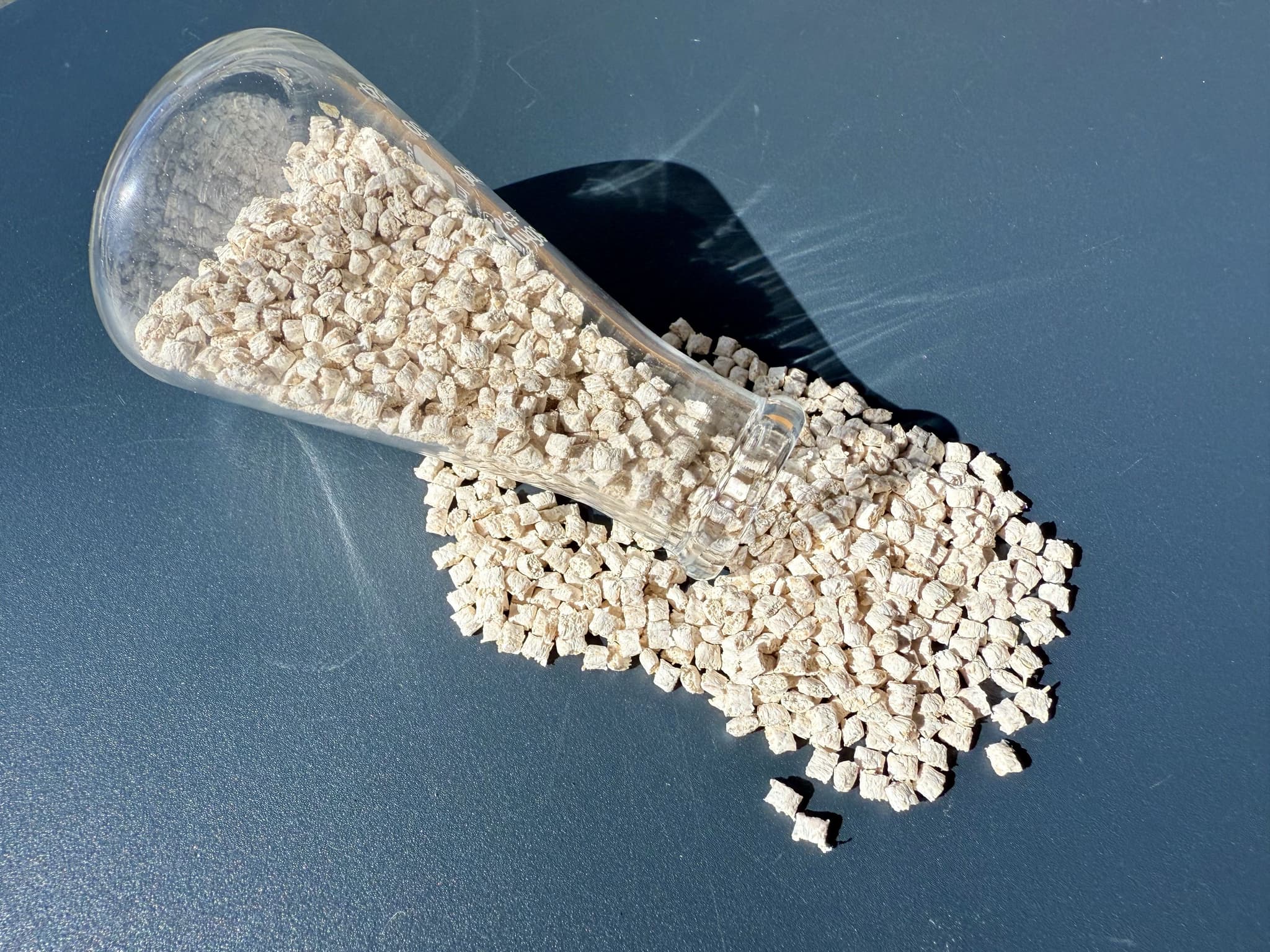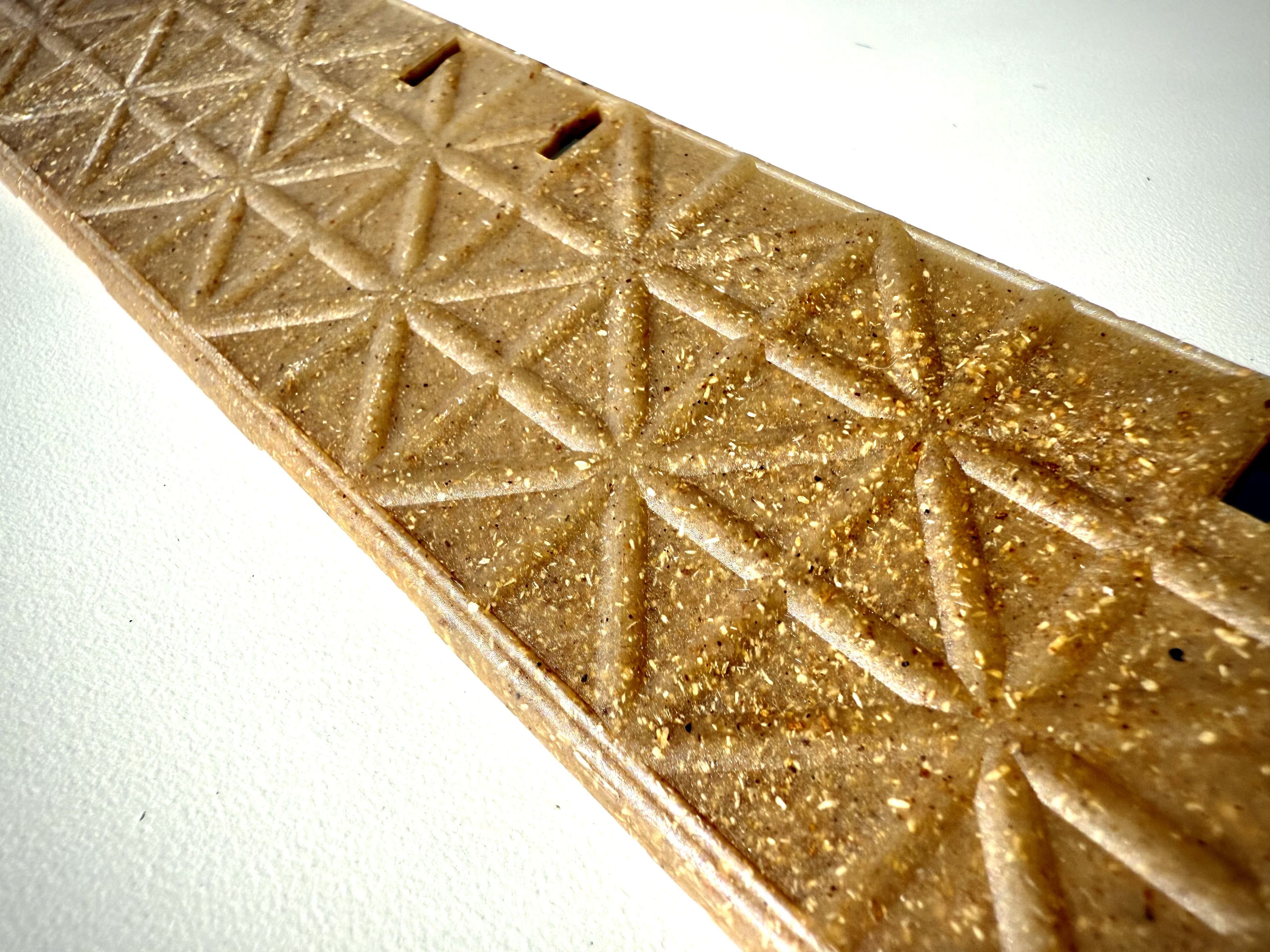1. How does the integration of plant fibers with recycled or biobased polymers in BioFi influence its mechanical properties compared to conventional thermoplastics?
Combining plant fibers with recycled or biobased polymers enhances the sustainability of BioFi compounds by significantly reducing their carbon footprint. Compared to conventional thermoplastics, recycled polymers tend to have lower mechanical properties and a narrower melt flow index (MFI) range. However, this limitation can be mitigated by selecting the appropriate grade of recycled polymer and using tailored additives and modifiers to achieve the desired performance.
Incorporating plant fibers enhances the modulus of polymers, providing higher stiffness. The synergy between these fibers and recycled polymers results in a promising, customizable material suitable for diverse applications.
Biopolymers fall into two categories:
- Biobased polymers (e.g., Bio PE, Bio PP): These have mechanical properties comparable to conventional thermoplastics but offer fewer grade variations, potentially limiting their use in specific applications. They are also more expensive, reducing commercial viability.
- Bio-compostable polymers: These require blending of various types to achieve balanced mechanical strength, as individual polymers often lack all necessary properties.

2. Could you elaborate on the specific processing parameters required for injection molding or extrusion of BioFi, and how they compare to those of standard polymers?
The key processing parameter for BioFi during injection molding or extrusion is temperature. BioFi compounds must be processed at temperatures ≤ 200°C (392°F) to avoid fiber degradation, which could negatively impact color and mechanical properties. Additionally, pre-drying may be necessary to remove residual moisture, ensuring optimal fabrication quality. This contrasts with standard thermoplastics, which can often withstand higher temperatures without such constraints.

3. In developing Jutin, what were the key considerations in selecting jute as a reinforcement material, and how does it affect the composite's performance metrics?
Jute was selected for Jutin due to its regional availability, low cost, and impressive environmental and mechanical attributes. As a lignocellulosic fiber, jute supports carbon management—with one hectare absorbing up to 15 tons of CO₂ and releasing 11 tons of O₂ in just 110 days.
From a performance standpoint, jute contributes to high tensile strength and good stiffness, improving structural integrity and reducing composite weight. Being biodegradable and cost-effective, jute strengthens both the sustainability and economic viability of Jutin.

4. What challenges did you encounter in achieving compatibility between jute fibers and the polymer matrix in Jutin, and how were these addressed?
A key challenge was the incompatibility between hydrophilic jute fibers and hydrophobic polymer matrices (e.g., unsaturated polyester resin). This polarity mismatch can weaken interfacial bonding, reducing stress transfer and composite strength.
To overcome this, various fiber surface modification techniques were employed:
- Chemical coupling agents were used to form bonds between fiber hydroxyl groups and polymer reactive groups.
- Physical treatments like calendaring enhanced mechanical interlocking.
These interventions improved tensile and bending strength, water resistance, and dimensional stability, enabling Jutin to meet rigorous performance standards.
5. How does the use of jute in Jutin contribute to its thermal and acoustic insulation properties, and what testing methods were employed to quantify these attributes?
Jute enhances Jutin’s thermal and acoustic insulation due to its hollow, porous microstructure that traps air, effectively reducing heat transfer and sound waves. The cohesive polymer matrix further strengthens these properties.
Key tests included:
- Thermal conductivity: Guarded Hot Plate Method (ASTM C177) revealed values between 0.05 and 0.07 W/m·K.
- Acoustic insulation: Impedance Tube Method (ASTM E1050) and Reverberation Room Method (ISO 10140) confirmed high sound transmission loss.
These results validate Jutin’s role in energy-efficient, eco-friendly building solutions.

6. Can you discuss the environmental impact assessments conducted for BioFi and Jutin, particularly in terms of lifecycle analysis and carbon footprint reduction?
Jutin underwent a comprehensive Life Cycle Analysis (LCA) adhering to ISO 14040 and ISO 14044. Jute, a carbon-negative crop, enriches soil, supports biodiversity, and requires minimal inputs.
During manufacturing, Jutin production has low energy demands and supports decentralized fabrication, reducing embodied energy and enabling local employment. In use, its insulation properties reduce operational emissions. At end-of-life, Jutin is either recyclable or safely disposable.
For BioFi, lifecycle assessments showed a 15–50% reduction in carbon footprint, varying by production site, raw materials, and fiber type. The natural fibers contribute to carbon sequestration and reduce reliance on petrochemical inputs.

7. What measures are taken to ensure the consistency and quality of plant-based raw materials used in your biocomposites, considering regional agricultural variations?
To ensure consistent performance and product quality, we have implemented comprehensive quality control processes starting at the raw material sourcing stage. This includes:
- Pre-production testing of plant-based raw materials to ensure they meet specified performance benchmarks.
- Close collaboration with suppliers, offering them guidance on the importance of adhering to the developed specifications.
This dual approach ensures that the properties of raw materials remain consistent despite variations in regional agriculture, preserving the integrity and reliability of our biocomposites.

8. How do BioFi and Jutin perform under long-term environmental exposure, such as UV radiation and moisture, and what stabilization strategies are implemented?
Jutin demonstrates exceptional durability in the face of prolonged UV radiation, moisture, and temperature variation. Uniquely, exposure to UV enhances mechanical properties by triggering additional polymer matrix curing, increasing tensile and impact strength by up to 14% and 53%, respectively. Its water absorption remains below 1% after three months, and mechanical properties improve slightly over prolonged exposure.
Stabilization strategies include:
- UV curing for complete polymerization
- Use of anti-bubbling and coupling agents for improved interfacial bonding
- Advanced surface treatments such as corona discharge, plasma treatment, and mercerization to reduce water sensitivity
Accelerated weathering tests (600+ hours) confirmed a minimal 10% reduction in mechanical strength, supporting Jutin’s reliability for outdoor applications like roofing and siding.
BioFi, while containing natural fibers susceptible to degradation, benefits from encapsulation in thermoplastics that significantly reduce moisture pickup. Proper fiber-polymer bonding enhances structural integrity and minimizes delamination risks. UV additives and inorganic pigments are employed to guard against long-term degradation, extending product life in varied environmental conditions.
9. Could you detail the scalability of your production processes for BioFi and Jutin, and how they accommodate varying industrial demands?
Jutin’s production is inherently scalable and adaptable to different industrial contexts. For low-tech, decentralized needs, manual lay-up techniques using jute hessian cloth and resin allow fabrication without complex machinery or skilled labor. This model supports rural employment, especially for women, and reduces infrastructure demands and CO₂ emissions.
For industrial-scale production, processes like resin infusion and compression molding provide higher throughput and quality consistency. Customization is possible through variation in fiber content, resin type, or additives such as UV stabilizers or pigments. The supply chain for jute, particularly strong in Bangladesh and India, supports high-volume production.
BioFi uses extrusion lines that can be scaled by adjusting screw diameter or length-to-diameter ratio (L/D). The platform accepts a wide range of natural fibers (jute, hemp, rice husk) and thermoplastics (PP, PE, PLA), allowing quick adaptation to regional feedstock availability and performance needs.

10. What advancements or innovations are you exploring to enhance the properties or applications of your biocomposite materials?
Innovation at our end focuses on performance enhancement and application expansion. For Jutin, current R&D includes:
- Development of fire-retardant variants for urban housing and disaster relief structures
- Creating lightweight composites for integrated housing panels
- Exploring bio-based resins to increase renewability and biodegradability
We're also assessing natural fiber hybrids, nanomaterial reinforcements, and advanced surface treatments (plasma, enzymatic methods) to optimize bonding, durability, and resistance to weathering.
On the BioFi front, we continue to tailor grades for food contact, high-impact resistance, microwave safety, and temperature resilience. We are expanding from injection molding to extrusion and thermoforming, broadening application potential. Additionally, we actively explore new agricultural waste streams to reduce material costs and enhance performance.








